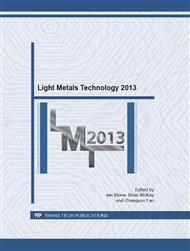p.602
p.607
p.612
p.618
p.623
p.629
p.634
p.639
p.644
Relating Grain Misorientation to the Corrosion Behaviour of Low Copper 7xxx Aluminium Alloys
Abstract:
High strength aluminium alloys provide benefits in vehicle efficiency and reduced energy consumption. Weldable, low copper 7xxx aluminium alloys are being developed for body-in-white production. Here, the influences of thermomechanical history on microstructure and, consequently, on the corrosion behaviour of lean 7xxx aluminium alloy sheet have been investigated. Cold worked microstructures in the alloys studied are susceptible to sub-surface cracking after accelerated corrosion testing. High resolution transmission electron microscopy (HAADF) with allied EDX analysis of a warm rolled alloy has revealed significant differences between some grain boundaries, showing differences in grain boundary precipitate distribution, which is influenced by grain misorientation and thermomechanical processing history. Possible relationships between the previously described phenomena are being sought. Electron backscatter diffraction has been employed to provide crystallographic information concerning grain orientation relationships from specific areas surrounding the attacked microstructure.
Info:
Periodical:
Pages:
623-628
Citation:
Online since:
July 2013
Price:
Сopyright:
© 2013 Trans Tech Publications Ltd. All Rights Reserved
Share:
Citation:


